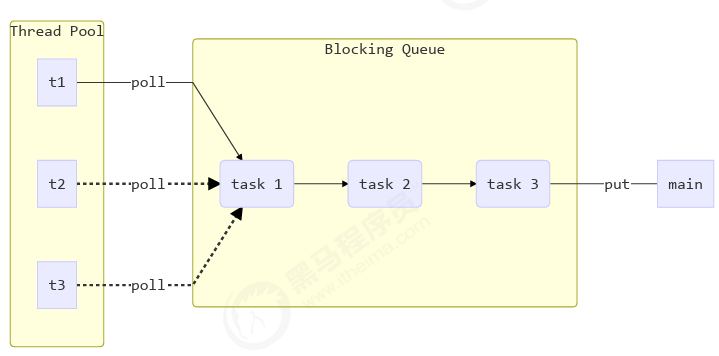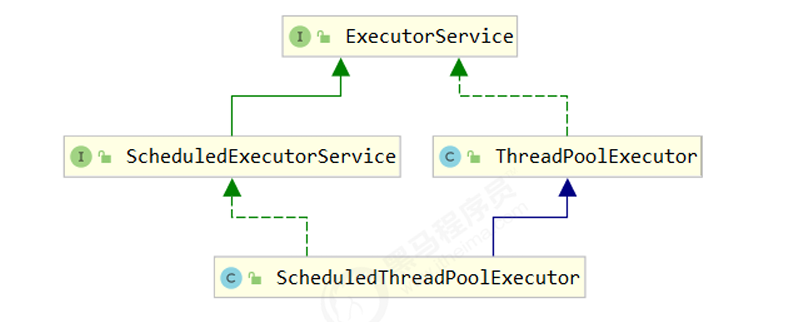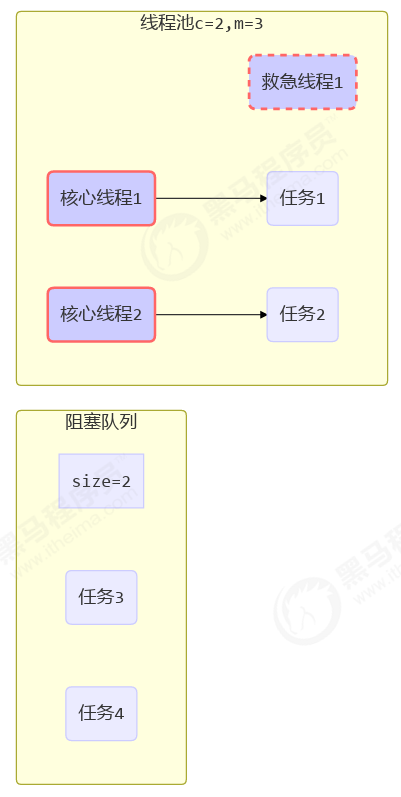java并发编程十三 线程池
发布时间:2023年12月29日
线程池
自定义线程池

步骤1:自定义拒绝策略接口
@FunctionalInterface // 拒绝策略
public interface RejectPolicy<T> {
void reject(BlockingQueue<T> queue, T task);
}
步骤2:自定义任务队列
@Slf4j
public class BlockingQueue<T> {
// 1. 任务队列
private Deque<T> queue = new ArrayDeque<>();
// 2. 锁
private ReentrantLock lock = new ReentrantLock();
// 3. 生产者条件变量
private Condition fullWaitSet = lock.newCondition();
// 4. 消费者条件变量
private Condition emptyWaitSet = lock.newCondition();
// 5. 容量
private int capcity;
public BlockingQueue(int capcity) {
this.capcity = capcity;
}
// 带超时阻塞获取
public T poll(long timeout, TimeUnit unit) {
lock.lock();
try {
// 将 timeout 统一转换为 纳秒
long nanos = unit.toNanos(timeout);
while (queue.isEmpty()) {
try {
// 返回值是剩余时间
if (nanos <= 0) {
return null;
}
nanos = emptyWaitSet.awaitNanos(nanos);
} catch (InterruptedException e) {
e.printStackTrace();
}
}
T t = queue.removeFirst();
fullWaitSet.signal();
return t;
} finally {
lock.unlock();
}
}
// 阻塞获取
public T take() {
lock.lock();
try {
while (queue.isEmpty()) {
try {
emptyWaitSet.await();
} catch (InterruptedException e) {
e.printStackTrace();
}
}
T t = queue.removeFirst();
fullWaitSet.signal();
return t;
} finally {
lock.unlock();
}
}
// 阻塞添加
public void put(T task) {
lock.lock();
try {
while (queue.size() == capcity) {
try {
log.debug("等待加入任务队列 {} ...", task);
fullWaitSet.await();
} catch (InterruptedException e) {
e.printStackTrace();
}
}
log.debug("加入任务队列 {}", task);
queue.addLast(task);
emptyWaitSet.signal();
} finally {
lock.unlock();
}
}
// 带超时时间阻塞添加
public boolean offer(T task, long timeout, TimeUnit timeUnit) {
lock.lock();
try {
long nanos = timeUnit.toNanos(timeout);
while (queue.size() == capcity) {
try {
if(nanos <= 0) {
return false;
}
log.debug("等待加入任务队列 {} ...", task);
nanos = fullWaitSet.awaitNanos(nanos);
} catch (InterruptedException e) {
e.printStackTrace();
}
}
log.debug("加入任务队列 {}", task);
queue.addLast(task);
emptyWaitSet.signal();
return true;
} finally {
lock.unlock();
}
}
public int size() {
lock.lock();
try {
return queue.size();
} finally {
lock.unlock();
}
}
public void tryPut(RejectPolicy<T> rejectPolicy, T task) {
lock.lock();
try {
// 判断队列是否满
if(queue.size() == capcity) {
rejectPolicy.reject(this, task);
} else { // 有空闲
log.debug("加入任务队列 {}", task);
queue.addLast(task);
emptyWaitSet.signal();
}
} finally {
lock.unlock();
}
}
}
步骤3:自定义线程池
@Slf4j
public class ThreadPool { // 任务队列
private BlockingQueue<Runnable> taskQueue;
// 线程集合
private HashSet<Worker> workers = new HashSet<>();
// 核心线程数
private int coreSize;
// 获取任务时的超时时间
private long timeout;
private TimeUnit timeUnit;
private RejectPolicy<Runnable> rejectPolicy;
// 执行任务
public void execute(Runnable task) {
// 当任务数没有超过 coreSize 时,直接交给 worker 对象执行
// 如果任务数超过 coreSize 时,加入任务队列暂存
synchronized (workers) {
if(workers.size() < coreSize) {
Worker worker = new Worker(task);
log.debug("新增 worker{}, {}", worker, task);
workers.add(worker);
worker.start();
} else {
// taskQueue.put(task);
// 1) 死等
// 2) 带超时等待
// 3) 让调用者放弃任务执行
// 4) 让调用者抛出异常
// 5) 让调用者自己执行任务
taskQueue.tryPut(rejectPolicy, task);
}
}
}
public ThreadPool(int coreSize, long timeout, TimeUnit timeUnit, int queueCapcity,
RejectPolicy<Runnable> rejectPolicy) {
this.coreSize = coreSize;
this.timeout = timeout;
this.timeUnit = timeUnit;
this.taskQueue = new BlockingQueue<>(queueCapcity);
this.rejectPolicy = rejectPolicy;
}
class Worker extends Thread{
private Runnable task;
public Worker(Runnable task) {
this.task = task;
}
@Override
public void run() {
// 执行任务
// 1) 当 task 不为空,执行任务
// 2) 当 task 执行完毕,再接着从任务队列获取任务并执行
// while(task != null || (task = taskQueue.take()) != null) {
while(task != null || (task = taskQueue.poll(timeout, timeUnit)) != null) {
try {
log.debug("正在执行...{}", task);
task.run();
} catch (Exception e) {
e.printStackTrace();
} finally {
task = null;
}
}
synchronized (workers) {
log.debug("worker 被移除{}", this);
workers.remove(this);
}
}
}
}
步骤4:测试
public static void main(String[] args) {
ThreadPool threadPool = new ThreadPool(1,
1000, TimeUnit.MILLISECONDS, 1, (queue, task)->{
// 1. 死等
// queue.put(task);
// 2) 带超时等待
// queue.offer(task, 1500, TimeUnit.MILLISECONDS);
// 3) 让调用者放弃任务执行
// log.debug("放弃{}", task);
// 4) 让调用者抛出异常
// throw new RuntimeException("任务执行失败 " + task);
// 5) 让调用者自己执行任务
task.run();
});
for (int i = 0; i < 4; i++) {
int j = i;
threadPool.execute(() -> {
try {
Thread.sleep(1000L);
} catch (InterruptedException e) {
e.printStackTrace();
}
log.debug("{}", j);
});
}
}
ThreadPoolExecutor

线程池状态
ThreadPoolExecutor 使用 int 的高 3 位来表示线程池状态,低 29 位表示线程数量
| 状态名 | 高 3 位 | 接收新任务 | 处理阻塞队列任务 | 说明 |
|---|---|---|---|---|
| RUNNING | 111 | Y | Y | |
| SHUTDOWN | 000 | N | Y | 不会接收新任务,但会处理阻塞队列剩余任务 |
| STOP | 001 | N | N | 会中断正在执行的任务,并抛弃阻塞队列任务 |
| TIDYING | 010 | 任务全执行完毕,活动线程为 0 即将进入终结 | ||
| TERMINATED | 011 | 终结状态 |
从数字上比较,TERMINATED > TIDYING > STOP > SHUTDOWN > RUNNING
这些信息存储在一个原子变量 ctl 中,目的是将线程池状态与线程个数合二为一,这样就可以用一次 cas 原子操作进行赋值
// c 为旧值, ctlOf 返回结果为新值
ctl.compareAndSet(c, ctlOf(targetState, workerCountOf(c))));
// rs 为高 3 位代表线程池状态, wc 为低 29 位代表线程个数,ctl 是合并它们
private static int ctlOf(int rs, int wc) { return rs | wc; }
构造方法
public ThreadPoolExecutor(int corePoolSize,
int maximumPoolSize,
long keepAliveTime,
TimeUnit unit,
BlockingQueue<Runnable> workQueue,
ThreadFactory threadFactory,
RejectedExecutionHandler handler)
- corePoolSize 核心线程数目 (最多保留的线程数)
- maximumPoolSize 最大线程数目
- keepAliveTime 生存时间 - 针对救急线程
- unit 时间单位 - 针对救急线程
- workQueue 阻塞队列
- threadFactory 线程工厂 - 可以为线程创建时起个好名字
- handler 拒绝策略
工作方式:

- 线程池中刚开始没有线程,当一个任务提交给线程池后,线程池会创建一个新线程来执行任务。
- 当线程数达到 corePoolSize 并没有线程空闲,这时再加入任务,新加的任务会被加入workQueue 队列排队,直到有空闲的线程。
- 如果队列选择了有界队列,那么任务超过了队列大小时,会创建 maximumPoolSize - corePoolSize 数目的线
程来救急。 - 如果线程到达 maximumPoolSize 仍然有新任务这时会执行拒绝策略。拒绝策略 jdk 提供了 4 种实现,其它著名框架也提供了实现
- AbortPolicy 让调用者抛出 RejectedExecutionException 异常,这是默认策略
CallerRunsPolicy 让调用者运行任务 - DiscardPolicy 放弃本次任务
- DiscardOldestPolicy 放弃队列中最早的任务,本任务取而代之
- Dubbo 的实现,在抛出 RejectedExecutionException 异常之前会记录日志,并 dump 线程栈信息,方便定位问题
- Netty 的实现,是创建一个新线程来执行任务
- ActiveMQ 的实现,带超时等待(60s)尝试放入队列,类似我们之前自定义的拒绝策略
- PinPoint 的实现,它使用了一个拒绝策略链,会逐一尝试策略链中每种拒绝策略
- AbortPolicy 让调用者抛出 RejectedExecutionException 异常,这是默认策略
- 当高峰过去后,超过corePoolSize 的救急线程如果一段时间没有任务做,需要结束节省资源,这个时间由keepAliveTime 和 unit 来控制。

根据这个构造方法,JDK Executors 类中提供了众多工厂方法来创建各种用途的线程池
newFixedThreadPool
public static ExecutorService newFixedThreadPool(int nThreads) {
return new ThreadPoolExecutor(nThreads, nThreads,
0L, TimeUnit.MILLISECONDS,
new LinkedBlockingQueue<Runnable>());
}
特点
- 核心线程数 == 最大线程数(没有救急线程被创建),因此也无需超时时间
- 阻塞队列是无界的,可以放任意数量的任务
newCachedThreadPool
public static ExecutorService newCachedThreadPool() {
return new ThreadPoolExecutor(0, Integer.MAX_VALUE,
60L, TimeUnit.SECONDS,
new SynchronousQueue<Runnable>());
}
特点
- 核心线程数是 0, 最大线程数是 Integer.MAX_VALUE,救急线程的空闲生存时间是 60s,意味着
- 全部都是救急线程(60s 后可以回收)
- 救急线程可以无限创建
- 队列采用了 SynchronousQueue 实现特点是,它没有容量,没有线程来取是放不进去的(一手交钱、一手交货)
SynchronousQueue<Integer> integers = new SynchronousQueue<>();
new Thread(() -> {
try {
log.debug("putting {} ", 1);
integers.put(1);
log.debug("{} putted...", 1);
log.debug("putting...{} ", 2);
integers.put(2);
log.debug("{} putted...", 2);
} catch (InterruptedException e) {
e.printStackTrace();
}
},"t1").start();
sleep(1);
new Thread(() -> {
try {
log.debug("taking {}", 1);
integers.take();
} catch (InterruptedException e) {
e.printStackTrace();
}
},"t2").start();
sleep(1);
new Thread(() -> {
try {
log.debug("taking {}", 2);
integers.take();
} catch (InterruptedException e) {
e.printStackTrace();
}
},"t3").start();
输出
11:48:15.500 c.TestSynchronousQueue [t1] - putting 1
11:48:16.500 c.TestSynchronousQueue [t2] - taking 1
11:48:16.500 c.TestSynchronousQueue [t1] - 1 putted...
11:48:16.500 c.TestSynchronousQueue [t1] - putting...2
11:48:17.502 c.TestSynchronousQueue [t3] - taking 2
11:48:17.503 c.TestSynchronousQueue [t1] - 2 putted...
newSingleThreadExecutor
public static ExecutorService newSingleThreadExecutor() {
return new FinalizableDelegatedExecutorService
(new ThreadPoolExecutor(1, 1, 0L, TimeUnit.MILLISECONDS,
new LinkedBlockingQueue<Runnable>()));
}
使用场景:
希望多个任务排队执行。线程数固定为 1,任务数多于 1 时,会放入无界队列排队。任务执行完毕,这唯一的线程也不会被释放。
区别:
- 自己创建一个单线程串行执行任务,如果任务执行失败而终止那么没有任何补救措施,而线程池还会新建一个线程,保证池的正常工作
- Executors.newSingleThreadExecutor() 线程个数始终为1,不能修改
- FinalizableDelegatedExecutorService 应用的是装饰器模式,只对外暴露了ExecutorService 接口,因此不能调用 ThreadPoolExecutor 中特有的方法
- Executors.newFixedThreadPool(1) 初始时为1,以后还可以修改
- 对外暴露的是 ThreadPoolExecutor 对象,可以强转后调用 setCorePoolSize 等方法进行修改
提交任务
// 执行任务
void execute(Runnable command);
// 提交任务 task,用返回值 Future 获得任务执行结果
<T> Future<T> submit(Callable<T> task);
// 提交 tasks 中所有任务
<T> List<Future<T>> invokeAll(Collection<? extends Callable<T>> tasks)
throws InterruptedException;
// 提交 tasks 中所有任务,带超时时间
<T> List<Future<T>> invokeAll(Collection<? extends Callable<T>> tasks,
long timeout, TimeUnit unit)
throws InterruptedException;
// 提交 tasks 中所有任务,哪个任务先成功执行完毕,返回此任务执行结果,其它任务取消
<T> T invokeAny(Collection<? extends Callable<T>> tasks)
throws InterruptedException, ExecutionException;
// 提交 tasks 中所有任务,哪个任务先成功执行完毕,返回此任务执行结果,其它任务取消,带超时时间
<T> T invokeAny(Collection<? extends Callable<T>> tasks,
long timeout, TimeUnit unit)
throws InterruptedException, ExecutionException, TimeoutException;
关闭线程池
shutdown
/*
线程池状态变为 SHUTDOWN- 不会接收新任务- 但已提交任务会执行完- 此方法不会阻塞调用线程的执行
*/
void shutdown();
public void shutdown() {
final ReentrantLock mainLock = this.mainLock;
mainLock.lock();
try {
checkShutdownAccess();
// 修改线程池状态
advanceRunState(SHUTDOWN);
// 仅会打断空闲线程
interruptIdleWorkers();
onShutdown(); // 扩展点 ScheduledThreadPoolExecutor
} finally {
mainLock.unlock();
}
// 尝试终结(没有运行的线程可以立刻终结,如果还有运行的线程也不会等)
tryTerminate();
}
shutdownNow
/*
线程池状态变为 STOP- 不会接收新任务- 会将队列中的任务返回- 并用 interrupt 的方式中断正在执行的任务
*/
List<Runnable> shutdownNow();
public List<Runnable> shutdownNow() {
List<Runnable> tasks;
final ReentrantLock mainLock = this.mainLock;
mainLock.lock();
try {
checkShutdownAccess();
// 修改线程池状态
advanceRunState(STOP);
// 打断所有线程
interruptWorkers();
// 获取队列中剩余任务
tasks = drainQueue();
} finally {
mainLock.unlock();
}
// 尝试终结
tryTerminate();
return tasks;
}
其它方法
// 不在 RUNNING 状态的线程池,此方法就返回 true
boolean isShutdown();
// 线程池状态是否是 TERMINATED
boolean isTerminated();
// 调用 shutdown 后,由于调用线程并不会等待所有任务运行结束,因此如果它想在线程池 TERMINATED 后做些事情,可以利用此方法等待
boolean awaitTermination(long timeout, TimeUnit unit) throws InterruptedException;
任务调度线程池
在『任务调度线程池』功能加入之前,可以使用 java.util.Timer 来实现定时功能,Timer 的优点在于简单易用,但由于所有任务都是由同一个线程来调度,因此所有任务都是串行执行的,同一时间只能有一个任务在执行,前一个任务的延迟或异常都将会影响到之后的任务。
public static void main(String[] args) {
Timer timer = new Timer();
TimerTask task1 = new TimerTask() {
@Override
public void run() {
log.debug("task 1");
sleep(2);
}
};
TimerTask task2 = new TimerTask() {
@Override
public void run() {
log.debug("task 2");
}
};
// 使用 timer 添加两个任务,希望它们都在 1s 后执行
// 但由于 timer 内只有一个线程来顺序执行队列中的任务,因此『任务1』的延时,影响了『任务2』的执行
timer.schedule(task1, 1000);
timer.schedule(task2, 1000);
}
输出
20:46:09.444 c.TestTimer [main] - start...
20:46:10.447 c.TestTimer [Timer-0] - task 1
20:46:12.448 c.TestTimer [Timer-0] - task 2
使用 ScheduledExecutorService 改写:
ScheduledExecutorService executor = Executors.newScheduledThreadPool(2);
// 添加两个任务,希望它们都在 1s 后执行
executor.schedule(() -> {
System.out.println("任务1,执行时间:" + new Date());
try { Thread.sleep(2000); } catch (InterruptedException e) { }
}, 1000, TimeUnit.MILLISECONDS);
executor.schedule(() -> {
System.out.println("任务2,执行时间:" + new Date());
}, 1000, TimeUnit.MILLISECONDS);
输出
任务1,执行时间:Thu Jan 03 12:45:17 CST 2019
任务2,执行时间:Thu Jan 03 12:45:17 CST 2019
正确处理执行任务异常
方法1:主动捉异常
ExecutorService pool = Executors.newFixedThreadPool(1);
pool.submit(() -> {
try {
log.debug("task1");
int i = 1 / 0;
}
catch (Exception e) {
log.error("error:", e);
}
});
输出
21:59:04.558 c.TestTimer [pool-1-thread-1] - task1
21:59:04.562 c.TestTimer [pool-1-thread-1] - error:
java.lang.ArithmeticException: / by zero
at cn.itcast.n8.TestTimer.lambda$main$0(TestTimer.java:28)
at java.util.concurrent.Executors$RunnableAdapter.call(Executors.java:511)
at java.util.concurrent.FutureTask.run(FutureTask.java:266)
at java.util.concurrent.ThreadPoolExecutor.runWorker(ThreadPoolExecutor.java:1149)
at java.util.concurrent.ThreadPoolExecutor$Worker.run(ThreadPoolExecutor.java:624)
at java.lang.Thread.run(Thread.java:748)
方法2:使用 Future
ExecutorService pool = Executors.newFixedThreadPool(1);
Future<Boolean> f = pool.submit(() -> {
log.debug("task1");
int i = 1 / 0;
return true;
});
log.debug("result:{}", f.get());
输出
21:54:58.208 c.TestTimer [pool-1-thread-1] - task1
Exception in thread "main" java.util.concurrent.ExecutionException:
java.lang.ArithmeticException: / by zero
at java.util.concurrent.FutureTask.report(FutureTask.java:122)
at java.util.concurrent.FutureTask.get(FutureTask.java:192)
at cn.itcast.n8.TestTimer.main(TestTimer.java:31)
Caused by: java.lang.ArithmeticException: / by zero
at cn.itcast.n8.TestTimer.lambda$main$0(TestTimer.java:28)
at java.util.concurrent.FutureTask.run(FutureTask.java:266)
at java.util.concurrent.ThreadPoolExecutor.runWorker(ThreadPoolExecutor.java:1149)
at java.util.concurrent.ThreadPoolExecutor$Worker.run(ThreadPoolExecutor.java:624)
at java.lang.Thread.run(Thread.java:748)
文章来源:https://blog.csdn.net/studycodeday/article/details/135252681
本文来自互联网用户投稿,该文观点仅代表作者本人,不代表本站立场。本站仅提供信息存储空间服务,不拥有所有权,不承担相关法律责任。 如若内容造成侵权/违法违规/事实不符,请联系我的编程经验分享网邮箱:chenni525@qq.com进行投诉反馈,一经查实,立即删除!
本文来自互联网用户投稿,该文观点仅代表作者本人,不代表本站立场。本站仅提供信息存储空间服务,不拥有所有权,不承担相关法律责任。 如若内容造成侵权/违法违规/事实不符,请联系我的编程经验分享网邮箱:chenni525@qq.com进行投诉反馈,一经查实,立即删除!
最新文章
- Python教程
- 深入理解 MySQL 中的 HAVING 关键字和聚合函数
- Qt之QChar编码(1)
- MyBatis入门基础篇
- 用Python脚本实现FFmpeg批量转换
- Python数据科学视频讲解:Python数据异常值处理
- 面试必考精华版Leetcode1143. 最长公共子序列
- 【K8S 部署】基于kubeadm搭建Kurbernetes集群
- 多线程回调(Callback)编程模式使用
- java并发编程
- gRPC-Go基础(1)protoc的使用
- Python 爬虫之简单的爬虫(四)
- 158道软件测试面试题及答案!金九银十求职必备!
- 获奖公布 | 2023 冬季波卡黑客松大赛决赛 DemoDay 揭晓最高荣誉!
- LLM在社交媒体上应用的任务和挑战